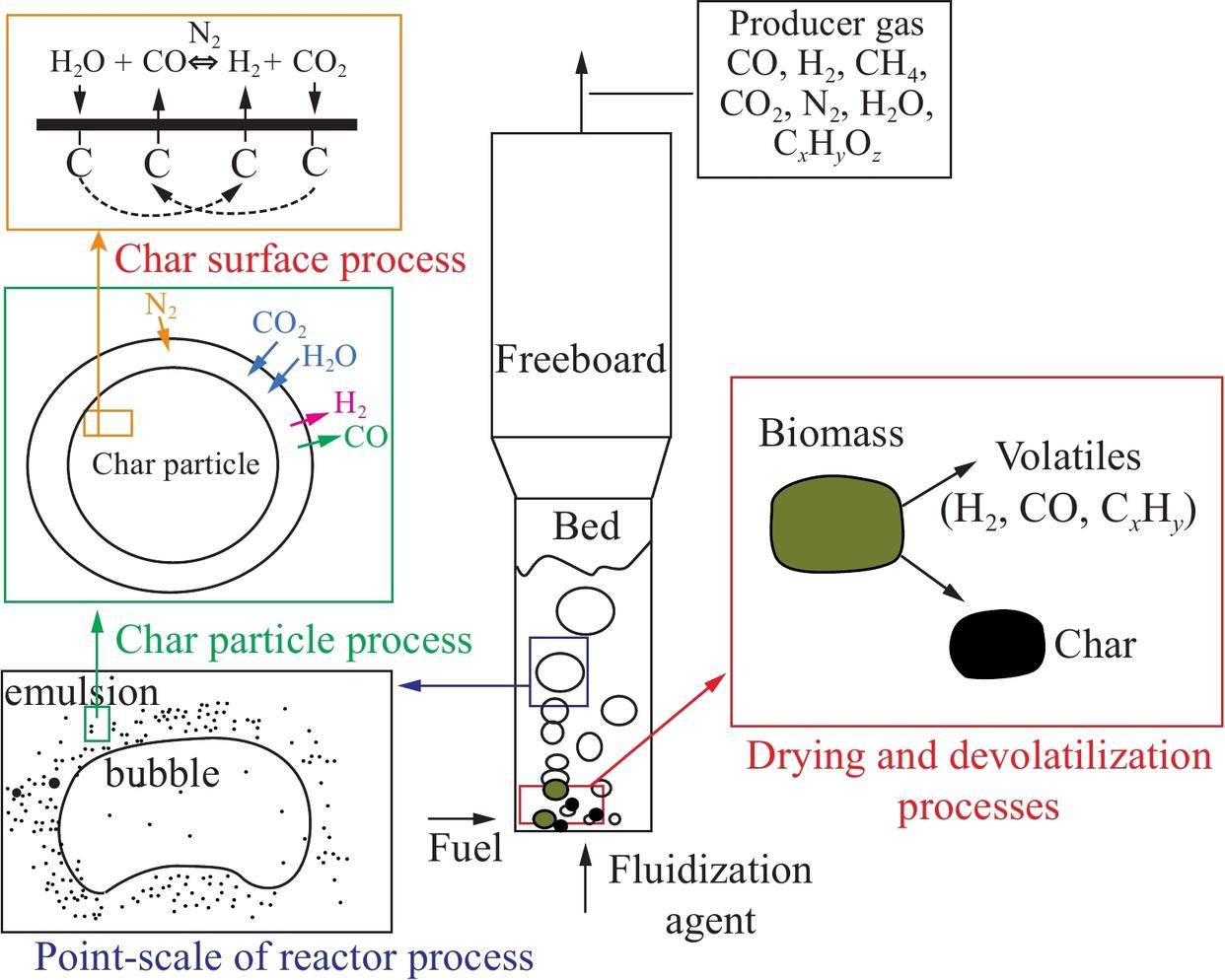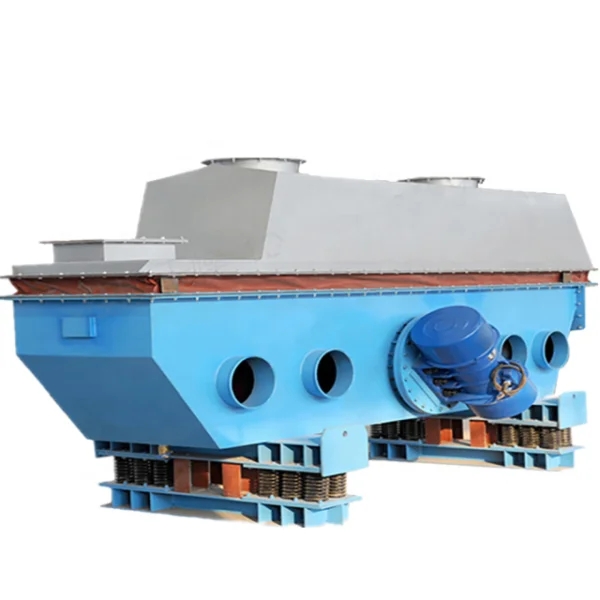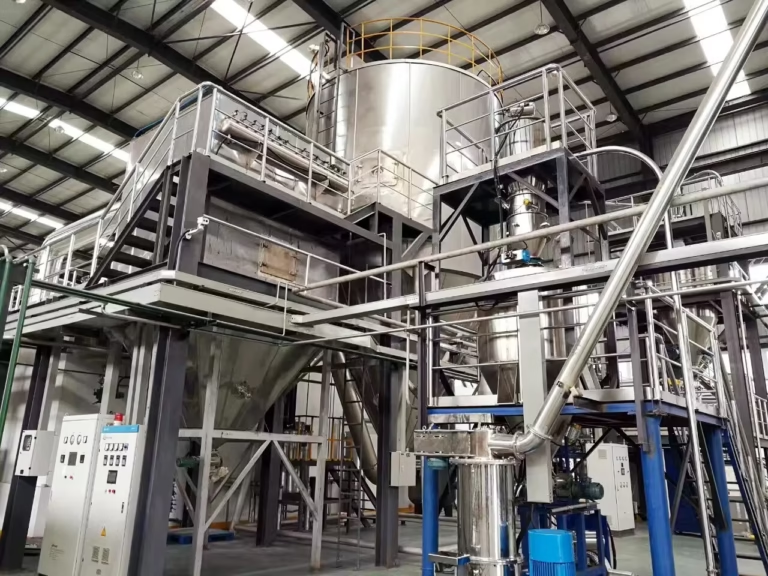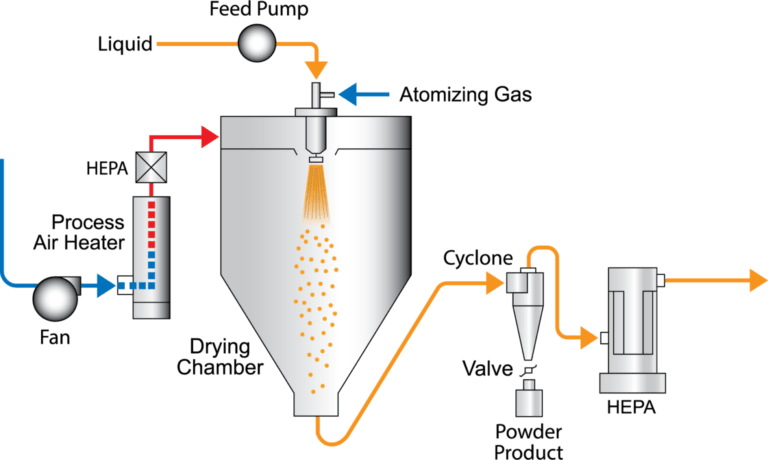流化的基本原理

当气体或液体以一定的速度向上通过细小的固体颗粒时,就会发生流化。 表现得像流体.
基本原理涉及流体的向上力平衡颗粒的重量, 使它们快速升起并混合.
当固体床膨胀时,您会看到流化状态 气泡形式, 很像沸水.
流化原理让您实现极佳的混合, 传热, 和化学反应.
许多行业依赖此流程来实现高效运营.
关键要点
当气体或液体向上穿过固体颗粒时发生流化, 使它们表现得像流体. 该过程增强了混合和传热.
了解影响流化的因素, 例如颗粒大小和密度, 有助于提高工业应用的效率.
流化床反应器因其能够有效混合固体和流体而广泛应用于化学制造和能源生产等行业.
使用流态化比传统方法具有优势, 包括对各种材料更好的湿度控制和更快的干燥时间.
监测温度和气流对于流化床的安全高效运行至关重要, 确保最佳性能.
基本原理
流化解释
通过观察气体或液体通过细小固体颗粒时的行为,您可以了解流化的基本原理. 基本原理是从流体向上运动开始. 这种运动产生了提升颗粒的力. 当向上的力与颗粒的重量相匹配时, 固体床开始膨胀. 你会看到气泡形成, 并且颗粒快速混合. 床的作用就像沸腾的液体.
颗粒床中初期不稳定的开始是在间隙中稳定的气体扩散之前,并且是由可以克服颗粒惯性的临界动量力引起的. 临界动量力由临界表观气体速度提供 Uc 以扩散临界质量通量的形式. 发现颗粒的第一次运动可以通过临界瞬态瑞利数来预测,该临界瞬态瑞利数由临界空塔速度等于最小流化速度确定, UMF. 发现初始流化的开始发生在 临界瞬态瑞利数 3.1, 这接近由自由表面界定的多孔介质中浮力对流的最低理论值.
需要关注影响基本原理的几个重要因素. 这些包括颗粒密度, 尺寸, 形状, 以及颗粒如何堆积在一起. 流体穿过床的方式也很重要. 您可以在下表中看到这些因素如何协同作用:
方面 | 发现 |
|---|---|
颗粒密度影响 | 颗粒密度越高,流化性能越差 在初始阶段. |
流体动力学 | 观察到对流体动力学的显着影响, 对高密度粒子的预测存在错误. |
流化阶段 | 确定了三个不同的流化阶段, 受粒度分布的影响. |
粒度分布 | 窄 PSD 带来更好的流动性和更低的最小流化速度 (U*mf). |
C 组颗粒 | 更宽的 PSD 导致更高的床膨胀并改善气固接触. |
纳米调制 | 提高 C 组粉末的流化质量, 表明规模和分布的重要性. |
您可以在流化过程中看到不同的行为,具体取决于颗粒的类型. 例如:
Geldart B/D颗粒容易形成气泡, 但床并没有扩大太多.
Geldart A 颗粒均匀膨胀, 这使得床更稳定.
气流过程中冲击波和连续波穿过床层, 展示基本原理如何实时工作.
流化的基本原理帮助您实现更好的混合和传热. 您可以在许多行业中使用此流程, 例如化学制造和能源生产.
两相理论
您可以探索 两相理论 更深入地了解流化的基本原理. 该理论认为床层包含两个主要相: 固体颗粒和流体 (气体或液体). 流体通过向上推动颗粒来支撑颗粒. 由于流体的阻力和浮力,颗粒移动并混合.
几何, 颗粒固体材料的物理和空气动力学特性都会影响流化的开始, 和特点, 流化床的行为和主要参数. 最重要的固体特性是: 粒子密度, 骨骼的 (真的) 密度, 堆积密度, 孔隙率, 平均当量粒径, 颗粒形状, 粒度分布, 和自由落体 (或终端) 速度.
您可以看到两相理论如何随着时间的推移而发展:
阶段 | 描述 | 时间段 |
|---|---|---|
1 | 20 世纪 40 年代初 | |
2 | 两相理论简介 | 20世纪50年代初 |
3 | 气泡流体动力学研究 | 20世纪60年代初 |
4 | 悬架结构的一般认识 | 世纪之交 |
两相理论可帮助您预测床的表现. 您可以看到床上的密集区域和稀疏区域. 流体和固相相互作用, 这导致不同的流动模式. 下表显示了科学家如何研究这些模式:
方面 | 细节 |
|---|---|
学习重点 | 密相循环流化床中的气固流动 (循环流化床) |
操作条件 | 空塔气速: 15.5 多发性硬化症; 固体助焊剂: 140 公斤/平方米; Geldart B 颗粒 (沙) |
主要发现 | 轴向固体浓度分布显示出稀区域和浓区域. 观察到的核心-环空结构和近壁返混. |
阻力模型 | 提出了基于 EMMS 模型的修正阻力系数并用于 CFD 模拟. |
验证方法 | 将实验结果与 CFD 模拟进行比较,以评估流动结构和压降. |
结论 | EMMS 阻力模型与实验数据表现出更好的一致性, 验证其在模拟中的使用. |
在两相理论中, 你会看到固相由液相支撑. 流化过程取决于流体提升和混合颗粒的程度. 您可以利用这一基本原理来改善反应器中的化学反应和传热.
流化床

流化床的工作原理
通过观察从固体颗粒床下方引入空气或液体时发生的情况,您可以了解流化床的运行方式. 向上的气流将颗粒提升, 使它们移动和混合. 这种运动创建了一个动态系统,其中粒子的行为几乎像液体. 随着流体速度的变化,您会注意到不同的流动状态. 下表显示了床位如何随每种方案而变化:
流量类型 | 描述 |
|---|---|
固定床 | 粒子静止且未流态化的初始状态. |
鼓泡流化 | 床内形成气泡, 和粒子的相互作用更加活跃. |
段击流化 | 出现大气泡, 造成颗粒的不规则运动. |
湍流流化 | 水流变得汹涌澎湃, 并且颗粒快速混合. |
稀相传输 | 颗粒分散在气相中, 和浓度下降. |
快速流化 | 床就像流体一样, 具有强烈的气体和粒子相互作用. |
段塞流/气泡流 | 段塞和气泡同时存在, 创造混合运动. |
无气泡密相流 | 床保持密集, 并且气体流量仍然很低. |
填充床流量 | 颗粒紧密堆积, 并且流体运动最小. |
你可以 使用气体喷射将固体颗粒悬浮在连续液相中. 液体从顶部进入并逆气流运动. 气体分配器的设计让液体从底部排出,而不会带走颗粒. 这种机制允许您在连续流动反应器中使用细小或低密度的颗粒.
当您从粉末床下方引入空气时,会发生均匀混合. 空气提升并搅动颗粒, 将致密粉末变成流体状. 您可以将液体粘合溶液喷洒到流态化颗粒上,以帮助颗粒生长并改善混合.
主要特点
您会发现流化床的几个独特特征. 下表强调了这些重要方面:
主要特点 | 描述 |
|---|---|
高表面积接触 | 每个床体积中的流体和颗粒之间都有很大的接触面积. |
高相对速度 | 与彼此相比,流体和颗粒移动得更快. |
混合 | 颗粒在整个床上充分混合. |
碰撞 | 粒子之间以及与墙壁之间频繁发生碰撞. |
你需要考虑 建造流化床时的设计因素. 颗粒尺寸分布影响您需要的空气流量. 圆形颗粒的行为与椭圆形颗粒不同, 这会改变干燥均匀性. 堆积密度影响流化所需的最小速度并有助于防止材料损失. 比热告诉您加热颗粒需要多少能量. 脆弱的颗粒可能需要温和的流化以避免破碎. 化学成分可能会导致粘性或热敏性等问题. 入口空气温度必须与颗粒可以处理的温度相匹配. 空气流速控制流化状态和传热. 保留时间取决于气流和堰高度, 帮助您达到合适的湿度水平.
温度和压力也会影响流化床的工作方式. 气泡运动控制较低温度下的流动结构. 在较高温度下, 粒子粘在一起的方式变得更加重要. 超高温度增加颗粒间力, 这可以改变粒子的行为.
流化床反应器
工业应用
您可以在许多行业中找到流化床反应器. 这些反应器可帮助您更有效地处理化学反应和材料加工. 你看到它们用于炼油, 化学生产, 和能源生产. 这些反应器的设计可让您快速混合固体和液体, 这改善了流程.
以下是 流化床反应器的主要类型 你可能会遇到:
反应器类型 | 描述 |
|---|---|
疯牛病 (鼓泡流化床) | 带有反应器柱的简单设计, 分销商, 生物质螺旋喂料系统, 和旋风分离器用于去除细颗粒. |
循环流化床 (循环流化床) | 由反应柱组成, 多个旋风分离器, 和生物质螺旋喂料系统; 捕获并再循环粗颗粒和细颗粒. |
气流床 | 使用高气体速度保持颗粒悬浮. |
流化床反应器在多个方面发挥着关键作用 industrial applications:
Application Type | 描述 |
|---|---|
Oil and Chemical Processing | Used for continuous feeding and production of bio-oil. |
Synthesis of Acrylonitrile | Employed in the production of acrylonitrile. |
Catalytic Cracking | Utilized in petrochemical industries for catalytic processes. |
Heat Transfer | Efficient heat transfer with uniform bed temperatures. |
You also see these reactors in pharmaceutical manufacturing. They help you dry powders, coat tablets, and mix ingredients. The market for fluidized bed reactors keeps growing. 在 2024, the market reached USD 3.5 billion. Experts expect it to rise to USD 5.9 十亿 2033, with a steady growth rate.
好处
Fluidized bed reactors offer many advantages for industrial processes. You get better mixing and faster reactions. The design lets you control temperature and material flow easily. You can use these reactors for chemical synthesis, pollution reduction, and material processing.
Benefit/Application | 描述 |
|---|---|
Chemical Synthesis | Used for synthesizing key plastics like polyethylene and polypropylene, and producing monomers. |
Pollution Reduction | Generates less pollution by using sorbents to capture sulfur and operates at lower temperatures. |
Material and Heat Transfer | Facilitates efficient coating, drying of pharmaceuticals, and quick freezing of food products. |
You notice that heat and mass transfer rates in fluidized beds are much higher than in fixed bed reactors. This makes them ideal for reactions that need efficient heat and mass transfer. You can maintain uniform temperature distribution, which helps with heat transfer. The technology also allows you to regenerate catalysts often without stopping the process.
Fluidized bed reactors help you improve product quality in pharmaceutical manufacturing. You can dry and coat pharmaceutical powders evenly. You also reduce pollution and energy use, which benefits both the environment and your business.
Comparison
Traditional Methods
When you use traditional methods to handle fine solids, you often face many challenges. These methods include free solids splashing, directed gas injection, slugging, and solids entrainment. Each method has its own transport rate and energy efficiency. You can see the differences in the table below:
方法 | Transport Rate (kg/m²·s) | 能源效率 |
|---|---|---|
Free Solids Splashing | 5 × 10⁻²–2 × 10³ | Highest |
Directed Gas Injection | 1.9–4.3 m/s | Intermediate |
Slugging | 不适用 | Intermediate |
Confined Solids Splashing | 不适用 | Lowest |
Solids Entrainment | 不适用 | Lowest |
You may notice that these methods do not always provide high efficiency, especially when you need to control moisture or achieve uniform mixing. Traditional systems often struggle with removing small trash, which can clog pumps and cause scum to build up. Heavy debris can damage equipment, so you need extra screening devices. When you handle high-solids loads, you must use fine screens and grinders to remove debris. These steps lower the overall efficiency and make it hard to control moisture levels.
局限性 | Impact on Operations |
|---|---|
Causes clogging of pumps and scum accumulation in digesters. | |
Damage from heavy debris | Necessitates additional screening devices to prevent equipment overload. |
Inability to handle high-solids loads | Requires a fine screen coupled with a grinder for effective debris removal in high-solids situations. |
Advantages of Fluidization
When you use fluidization, you gain several advantages over traditional methods. The working principle of fluidization lets you achieve higher efficiency in mixing, 传热, and moisture control. You can process a wide range of materials, from grains and spices to chemicals and pharmaceuticals, without changing your equipment. This flexibility means you can dry products with different moisture levels and reach a faster drying time.
Fluidized bed drying adapts to many food products, such as grains, snacks, 和香料.
You can use the same equipment in different industries, including pharmaceuticals and chemicals.
The working principle allows you to process materials with various moisture contents, showing great operational flexibility.
You also get better process control and mixing. The working principle of fluidization, especially when combined with vibration, reduces the strong forces between fine particles. This makes it easier to mix and fluidize even the smallest particles. You achieve more even moisture removal and higher efficiency in drying and processing.
Fluidization with vibration breaks up clumps and improves mixing.
You can handle fine particles that are hard to process with traditional methods.
The process gives you more control, leading to better efficiency and more uniform moisture content.
提示: When you need to dry products quickly and evenly, fluidization gives you a faster drying time and helps you reach the desired moisture level with less energy.
You have learned that fluidization turns solid particles into a fluid-like state, which helps you mix, 热, and process materials more efficiently. Fluidized beds and reactors play a key role in many industries. The table below shows some important benefits:
Application Area | 好处 |
|---|---|
Enhances charging and discharging in solar power plant energy storage systems. | |
Industrial Processes | Increases heat and mass transfer efficiency in various industrial applications. |
High Temperature Energy Storage | Improves power output in sensible and phase-change energy storage systems. |
Research into new fluidization methods, 喜欢 Fluidized Bed Fenton technology, can help you treat wastewater better and reduce pollution. You can explore these advances to improve your own work or studies.
常问问题
What is fluidization used for in industry?
You use fluidization to improve mixing, 烘干, 和化学反应. Many industries rely on this process to boost energy efficiency and product quality. You often see it in food, 化学, and pharmaceutical manufacturing.
How do you control a fluidized bed?
You control a fluidized bed by adjusting the flow rate of gas or liquid. This lets you manage temperature, mixing, and particle movement. Good control helps you achieve better results and maintain energy efficiency.
Why does fluidization improve energy efficiency?
Fluidization improves energy efficiency because it increases contact between particles and fluids. You get faster heat transfer and better mixing. This means you use less energy to reach the same results.
Can you use fluidization for small particles?
是的, you can use fluidization for small particles. You may need special equipment to control the process. This helps you avoid particle loss and maintain stable operation.
What safety tips should you follow with fluidized beds?
You should monitor temperature and pressure closely. Always control the airflow to prevent overheating or blockages. Regular checks keep your system safe and efficient.






